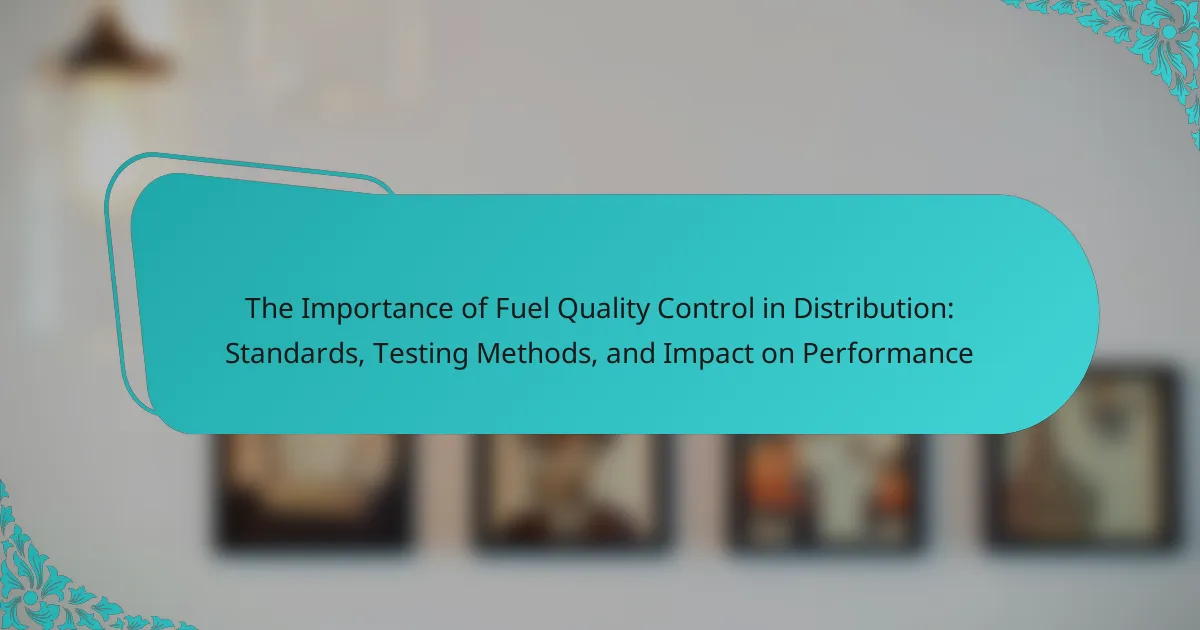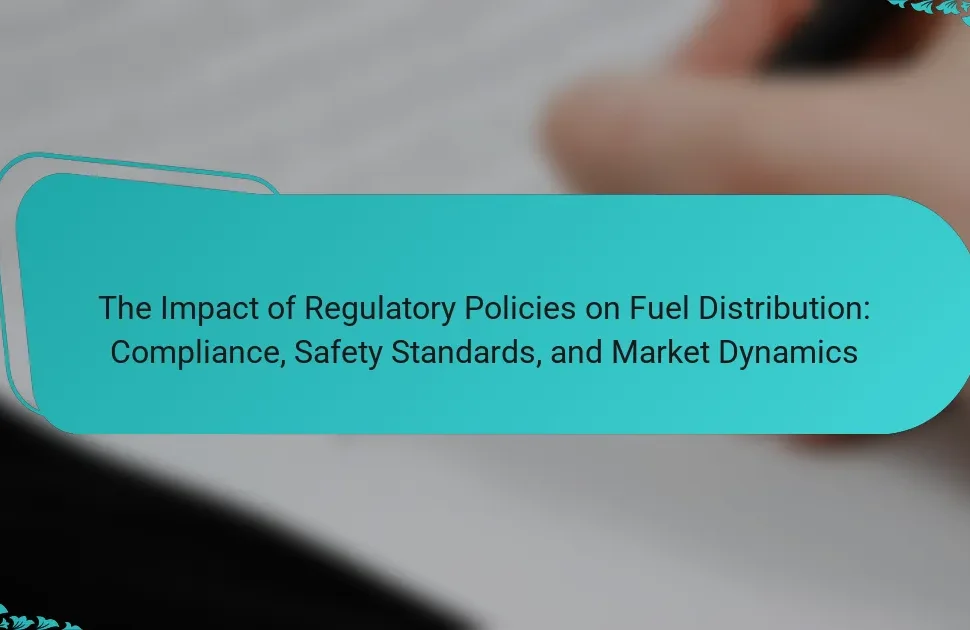
What is Fuel Quality Control in Distribution?
Fuel Quality Control in Distribution refers to the processes and measures taken to ensure that fuel meets specific quality standards throughout its distribution chain. This includes monitoring fuel characteristics such as purity, viscosity, and chemical composition. Effective fuel quality control prevents contamination and degradation during transportation and storage. It involves testing methods like sampling, laboratory analysis, and adherence to regulatory standards. These measures are essential to maintain fuel performance and safety. Poor fuel quality can lead to engine damage and reduced efficiency. Thus, rigorous quality control is critical for operational reliability in the fuel distribution industry.
Why is Fuel Quality Control essential in distribution?
Fuel quality control is essential in distribution to ensure the integrity and performance of fuel products. It prevents contamination that can lead to engine damage and operational inefficiencies. Quality control measures include regular testing for impurities and compliance with industry standards. According to the American Society for Testing and Materials (ASTM), fuel must meet specific criteria to maintain performance and safety. Poor fuel quality can result in increased maintenance costs and reduced vehicle lifespan. Furthermore, consistent quality control enhances customer satisfaction and trust in fuel suppliers. Thus, effective fuel quality control is crucial for operational reliability and economic sustainability in distribution.
What are the risks of poor fuel quality in distribution?
Poor fuel quality in distribution poses several significant risks. It can lead to engine damage, resulting in costly repairs. Contaminated fuel can cause reduced engine performance. This may manifest as decreased fuel efficiency and increased emissions. Additionally, poor fuel quality can lead to operational downtime. Vehicles may experience mechanical failures due to impurities. This disrupts supply chains and can lead to financial losses. Furthermore, poor fuel can affect safety, increasing the risk of accidents. Maintaining high fuel quality standards is essential to mitigate these risks.
How does fuel quality impact overall performance?
Fuel quality significantly impacts overall performance in engines and machinery. High-quality fuel enhances combustion efficiency. This leads to better power output and improved fuel economy. Conversely, low-quality fuel can cause engine knocking and reduced performance. It may also lead to increased emissions and engine wear. Studies show that using higher octane fuel can improve horsepower in gasoline engines. Additionally, diesel engines benefit from cleaner fuels that reduce carbon deposits. Overall, maintaining fuel quality is crucial for optimal performance and longevity of engines.
What are the key standards for Fuel Quality Control?
Key standards for Fuel Quality Control include ASTM D975, ISO 8217, and EN 590. ASTM D975 outlines specifications for diesel fuels, ensuring they meet performance and safety requirements. ISO 8217 provides standards for marine fuels, focusing on quality and compatibility. EN 590 specifies requirements for diesel fuel used in road vehicles, ensuring environmental compliance. These standards help prevent fuel contamination and ensure efficient engine performance. Compliance with these standards is essential for maintaining fuel quality and reliability in distribution.
Which organizations establish fuel quality standards?
Organizations that establish fuel quality standards include the American Society for Testing and Materials (ASTM), the International Organization for Standardization (ISO), and the European Committee for Standardization (CEN). ASTM develops and publishes voluntary consensus technical standards for materials, products, systems, and services. ISO creates international standards to ensure quality, safety, and efficiency across various sectors, including fuels. CEN focuses on developing European standards to enhance the quality and safety of fuels within the European Union. These organizations play a crucial role in setting benchmarks for fuel quality, ensuring compliance, and promoting best practices in the industry.
What are the specific parameters defined in these standards?
The specific parameters defined in fuel quality control standards include viscosity, density, and flash point. Viscosity measures the fluid’s resistance to flow, impacting pump efficiency. Density indicates the mass per unit volume, affecting energy content and combustion efficiency. Flash point determines the temperature at which fuel vapors ignite, ensuring safety during handling and storage. These parameters are crucial for maintaining fuel performance and compliance with regulatory requirements. Standards such as ASTM D975 provide detailed specifications for these attributes.

How is Fuel Quality Tested in Distribution?
Fuel quality is tested in distribution through various standardized methods. These methods include sampling, laboratory analysis, and field tests. Sampling involves collecting fuel from different points in the distribution system. This ensures that the fuel quality is representative of the entire batch. Laboratory analysis examines physical and chemical properties. Tests measure parameters such as octane rating, sulfur content, and water presence. Field tests provide immediate results on fuel performance in real-world conditions. Regulatory bodies set standards that must be met for compliance. These standards help ensure fuel quality and safety during distribution.
What methods are used for testing fuel quality?
Common methods for testing fuel quality include physical and chemical analysis. Physical analysis evaluates properties like density, viscosity, and flash point. Chemical analysis focuses on components such as sulfur content and octane rating.
Laboratory tests like gas chromatography measure specific hydrocarbons in the fuel. Spectroscopy methods can detect impurities and additives. Field tests often involve portable equipment for on-site assessments.
Standards set by organizations like ASTM International guide these testing methods. Adhering to these standards ensures fuel meets quality specifications, impacting performance and emissions.
How do laboratory tests differ from field tests?
Laboratory tests differ from field tests primarily in their controlled environment. Laboratory tests are conducted in a controlled setting where variables can be tightly regulated. This allows for precise measurements and repeatability of results. In contrast, field tests occur in real-world conditions. They are subject to environmental factors that can influence the outcomes.
Laboratory tests often utilize specialized equipment that provides detailed analysis. For example, chemical composition can be accurately determined in a lab. Field tests, however, may rely on portable equipment that offers quicker but less detailed results.
The accuracy of laboratory tests is typically higher due to the controlled conditions. Field tests, while practical, may introduce variability due to external factors. Therefore, while both testing types are essential, they serve different purposes in assessing fuel quality.
What are the most common testing equipment used?
The most common testing equipment used in fuel quality control includes gas chromatographs, octane testers, and flash point testers. Gas chromatographs analyze the chemical composition of fuels. They provide precise measurements of hydrocarbons and impurities. Octane testers measure the octane rating of fuels. This rating indicates fuel performance in engines. Flash point testers determine the temperature at which fuel vapors ignite. This measurement is crucial for safety assessments. Additional equipment may include density meters and viscosity testers. Density meters assess fuel density, while viscosity testers evaluate the flow characteristics of fuels. Each of these tools plays a vital role in ensuring fuel quality and compliance with industry standards.
How often should fuel quality testing be conducted?
Fuel quality testing should be conducted regularly, typically every batch or delivery. This frequency ensures that any contaminants or deviations from standards are detected promptly. Regular testing helps maintain fuel integrity and performance. Industry standards recommend testing at least once per month for stored fuel. Additionally, testing should occur whenever there are changes in supply sources. This practice minimizes the risk of fuel-related issues. Regular testing aligns with safety and regulatory compliance. Overall, consistent fuel quality testing is critical for optimal performance and reliability.
What factors influence the frequency of testing?
The frequency of testing is influenced by several factors. These factors include regulatory requirements, fuel type, and distribution methods. Regulatory bodies often set specific testing intervals to ensure compliance. Different fuel types may have varying stability and contamination risks, affecting testing frequency. Additionally, distribution methods, such as storage conditions, can impact fuel quality. For example, fuels stored in high-temperature environments may require more frequent testing. Industry best practices also recommend testing during significant operational changes. Lastly, historical data on fuel performance can inform testing schedules based on past issues.
How can regular testing prevent fuel quality issues?
Regular testing can prevent fuel quality issues by identifying contaminants and inconsistencies early. This proactive approach allows for timely corrective actions. Testing measures parameters like water content, sediment levels, and chemical composition. For instance, the American Society for Testing and Materials (ASTM) provides standards for fuel quality testing. Adhering to these standards helps maintain fuel integrity. Studies show that regular testing reduces the risk of engine damage and operational inefficiencies. By ensuring compliance with quality standards, distributors can enhance performance and reliability. Thus, regular testing is essential for sustaining fuel quality and preventing costly issues.

What is the Impact of Fuel Quality on Performance?
Fuel quality significantly impacts performance in engines. High-quality fuel ensures optimal combustion, leading to better energy output. It reduces engine knock and enhances efficiency. Poor fuel quality can cause deposits in fuel systems, leading to performance degradation. A study by the American Petroleum Institute found that low-quality fuel can decrease fuel economy by up to 10%. Moreover, it can result in increased emissions, affecting environmental compliance. Consistent fuel quality control is essential for maintaining performance standards in engine operation.
How does fuel quality affect engine performance?
Fuel quality significantly affects engine performance. High-quality fuel ensures optimal combustion efficiency. It allows engines to operate smoothly and produce maximum power. Poor fuel quality can lead to incomplete combustion. This results in reduced power output and increased emissions. Additionally, low-quality fuel may cause engine knocking. Engine knocking can damage components over time. Studies show that engines using high-quality fuel have better fuel economy. For example, a study by the American Petroleum Institute indicates that premium fuels can improve engine performance by up to 5%. Thus, the relationship between fuel quality and engine performance is critical for efficiency and longevity.
What specific performance metrics are influenced by fuel quality?
Fuel quality influences several specific performance metrics. These metrics include engine efficiency, power output, emissions levels, and fuel consumption rates. High-quality fuel typically leads to better engine performance and lower emissions. For instance, fuels with higher octane ratings can enhance engine efficiency and power output. Additionally, contaminants in fuel can result in increased emissions and reduced fuel economy. Research by the American Petroleum Institute indicates that fuel quality directly affects these performance metrics, confirming the importance of stringent fuel quality control.
How does fuel quality relate to emissions and environmental impact?
Fuel quality directly influences emissions and environmental impact. Higher quality fuels typically contain fewer impurities. These impurities, such as sulfur and particulates, can lead to increased emissions of harmful pollutants. For instance, low-sulfur fuels result in lower sulfur dioxide emissions, which contribute to acid rain and respiratory issues. The American Petroleum Institute states that improved fuel quality can reduce greenhouse gas emissions by up to 30%. Additionally, cleaner fuels enhance combustion efficiency, resulting in less unburned hydrocarbons released into the atmosphere. Consequently, using high-quality fuel is essential for minimizing environmental harm.
What are the economic implications of fuel quality control?
Fuel quality control has significant economic implications. It affects operational efficiency and maintenance costs for vehicles and machinery. High-quality fuel leads to improved engine performance and reduced emissions. This can lower fuel consumption and extend the lifespan of equipment. According to the U.S. Department of Energy, poor fuel quality can increase maintenance costs by up to 20%. Additionally, fuel quality standards can influence market prices. Compliance with these standards may lead to higher production costs but can enhance market competitiveness. In the long term, effective fuel quality control can contribute to overall economic stability by reducing environmental impact and promoting energy efficiency.
How can poor fuel quality lead to increased operational costs?
Poor fuel quality can lead to increased operational costs by causing engine inefficiencies and damage. Low-quality fuel often contains impurities that can clog fuel filters and injectors. This results in reduced fuel flow and decreased engine performance. Consequently, engines may consume more fuel to maintain power, increasing fuel expenses.
Additionally, contaminated fuel can lead to premature wear of engine components. This wear necessitates more frequent maintenance and repairs, driving up operational costs. According to the American Petroleum Institute, poor fuel quality can increase maintenance costs by up to 30%.
Furthermore, substandard fuel can lead to higher emissions. This may result in fines or penalties for exceeding environmental regulations. Overall, poor fuel quality significantly impacts operational efficiency and increases costs for businesses reliant on fuel.
What are the long-term benefits of investing in fuel quality control?
Investing in fuel quality control provides long-term benefits such as enhanced engine performance and reduced maintenance costs. High-quality fuel leads to better combustion efficiency. This results in lower emissions, contributing to environmental sustainability. Consistent fuel quality minimizes the risk of engine damage. It also prolongs the lifespan of equipment. According to the U.S. Department of Energy, proper fuel quality can improve fuel economy by up to 10%. Furthermore, reliable fuel quality control fosters customer trust and satisfaction. This can lead to increased market share and profitability for distributors.
What best practices should be followed for Fuel Quality Control?
Implementing best practices for fuel quality control is essential for maintaining fuel integrity. Regular testing of fuel samples is crucial to detect contaminants and ensure compliance with industry standards. Maintaining proper storage conditions prevents degradation and contamination of fuel. Utilizing certified equipment for testing enhances accuracy and reliability. Training personnel on quality control protocols ensures adherence to best practices. Documenting all testing and inspection results provides a clear record for accountability. Following these practices minimizes the risk of fuel-related issues and optimizes performance.
How can companies implement effective fuel quality management systems?
Companies can implement effective fuel quality management systems by establishing standardized procedures for fuel testing and monitoring. They should adopt industry standards such as ASTM or ISO for fuel quality assessment. Regular sampling and testing of fuel batches ensure compliance with specified quality parameters. Training staff on fuel quality issues enhances awareness and adherence to protocols. Implementing a robust documentation system tracks fuel quality data and trends over time. Utilizing technology, such as automated testing equipment, improves accuracy and efficiency in monitoring. Regular audits of the fuel management system identify areas for improvement. Collaboration with suppliers ensures that incoming fuel meets quality specifications. These practices collectively enhance fuel quality and operational performance.
What common pitfalls should be avoided in fuel quality control?
Common pitfalls in fuel quality control include inadequate testing procedures. Inconsistent sampling methods can lead to inaccurate results. Failing to adhere to established standards compromises fuel integrity. Neglecting staff training results in human error. Poor documentation practices hinder traceability and accountability. Incomplete analysis of fuel properties may overlook critical contaminants. Lack of regular equipment calibration affects measurement accuracy. Lastly, ignoring regulatory compliance can lead to legal repercussions.
Fuel Quality Control in Distribution is a critical process aimed at ensuring that fuel meets established quality standards throughout its distribution chain. This article covers the significance of fuel quality control, the risks associated with poor fuel quality, and the impact on engine performance and emissions. It details key standards and testing methods, including laboratory and field tests, as well as the economic implications of maintaining high fuel quality. Additionally, best practices for effective fuel quality management systems and common pitfalls to avoid are discussed, emphasizing the importance of rigorous quality control for operational reliability and sustainability.




